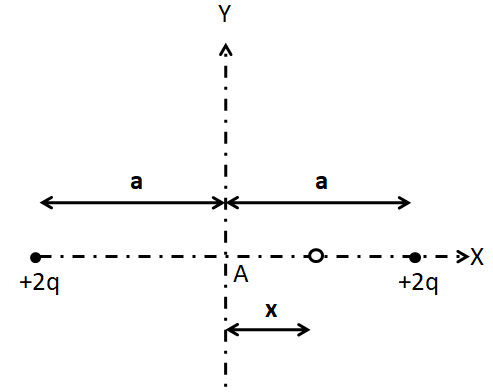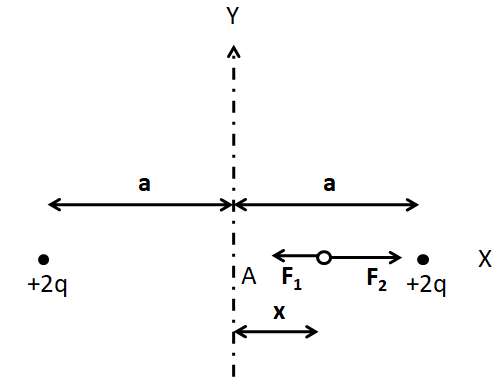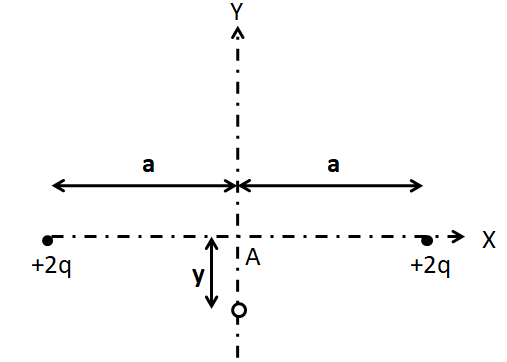
A point charge $ - q$ placed at the point A is

(A) In stable equilibrium along x-axis
(B) In unstable equilibrium along y-axis
(C) In stable equilibrium along y-axis
(D) In unstable equilibrium along x-axis
Answer
218.1k+ views
Hint: To determine the nature of equilibrium along a particular direction, we need to displace the charge by a small displacement along that direction. If the net force acting on the charge is towards the equilibrium position, then the equilibrium is stable. But if the net force is away from the equilibrium position, then the equilibrium is unstable.
Complete step-by-step solution:
As can be seen in the given figure, the charge particle is symmetrically placed with respect to both of the charges of $ + 2q$. So the charge is in equilibrium at the point A. Now, for determining the nature of this equilibrium along the x and the y axis, we displace the charge through a small displacement along these directions separately.
For x direction:
Let us displace the charge through a small displacement $x$ as shown in the below figure.

Since this charge is negative and both of the fixed charges are positive, so the charge will get attracted by the fixed charge. Let the force due to the left charge be \[{F_1}\] and that due to the right charge be ${F_2}$. So these can be shown in the figure below.

The distance of the charge from the left fixed charge is
${x_1} = a + x$
And the distance from the right fixed charge is
${x_2} = a - x$
Since the electrostatic force is inversely proportional to the square of the distance, so \[{F_1}\] will be less than ${F_2}$.
Therefore, the net force on the charge will be towards the right, that is, away from the equilibrium position A.
So the charge is in unstable equilibrium along the x-axis.
Therefore, the option D is correct.
For y direction:
Let us displace the charge through a small displacement $y$ as shown in the below figure.

Since the charge is negative, it will get attracted by both of the fixed charges by forces of \[{F_1}\] and that due to the right charge be ${F_2}$ as shown in the figure below.

Since the charge is symmetric with respect to both the fixed charges, so \[{F_1}\] will be equal to ${F_2}$.
Therefore, the horizontal components of both the forces will get cancelled and the vertical components of the forces will get added up. Thus, the net force on the charged particle will be vertically downwards, that is, towards the equilibrium position.
So the charge is in stable equilibrium along the y-axis.
Therefore, the option C is also correct.
Hence, the correct options are C and D.
Note: There is no need to determine the magnitude of the net force after displacing the particle. We only need to find out the direction of the net force for determining the nature of equilibrium.
Complete step-by-step solution:
As can be seen in the given figure, the charge particle is symmetrically placed with respect to both of the charges of $ + 2q$. So the charge is in equilibrium at the point A. Now, for determining the nature of this equilibrium along the x and the y axis, we displace the charge through a small displacement along these directions separately.
For x direction:
Let us displace the charge through a small displacement $x$ as shown in the below figure.

Since this charge is negative and both of the fixed charges are positive, so the charge will get attracted by the fixed charge. Let the force due to the left charge be \[{F_1}\] and that due to the right charge be ${F_2}$. So these can be shown in the figure below.

The distance of the charge from the left fixed charge is
${x_1} = a + x$
And the distance from the right fixed charge is
${x_2} = a - x$
Since the electrostatic force is inversely proportional to the square of the distance, so \[{F_1}\] will be less than ${F_2}$.
Therefore, the net force on the charge will be towards the right, that is, away from the equilibrium position A.
So the charge is in unstable equilibrium along the x-axis.
Therefore, the option D is correct.
For y direction:
Let us displace the charge through a small displacement $y$ as shown in the below figure.

Since the charge is negative, it will get attracted by both of the fixed charges by forces of \[{F_1}\] and that due to the right charge be ${F_2}$ as shown in the figure below.

Since the charge is symmetric with respect to both the fixed charges, so \[{F_1}\] will be equal to ${F_2}$.
Therefore, the horizontal components of both the forces will get cancelled and the vertical components of the forces will get added up. Thus, the net force on the charged particle will be vertically downwards, that is, towards the equilibrium position.
So the charge is in stable equilibrium along the y-axis.
Therefore, the option C is also correct.
Hence, the correct options are C and D.
Note: There is no need to determine the magnitude of the net force after displacing the particle. We only need to find out the direction of the net force for determining the nature of equilibrium.
Recently Updated Pages
Arithmetic, Geometric & Harmonic Progressions Explained

Cartesian Form of Vector Explained: Formula, Examples & Uses

Apparent Frequency Explained: Formula, Uses & Examples

Calorimetry: Definition, Principles & Calculations

Centrifugal Force Explained: Definition, Formula & Examples

Charge in a Magnetic Field: Definition, Formula & Examples

Trending doubts
JEE Main 2026: Application Form Open, Exam Dates, Syllabus, Eligibility & Question Papers

Derivation of Equation of Trajectory Explained for Students

Hybridisation in Chemistry – Concept, Types & Applications

Understanding the Angle of Deviation in a Prism

Understanding Collisions: Types and Examples for Students

Understanding Atomic Structure for Beginners

Other Pages
JEE Advanced Marks vs Ranks 2025: Understanding Category-wise Qualifying Marks and Previous Year Cut-offs

How to Convert a Galvanometer into an Ammeter or Voltmeter

Ideal and Non-Ideal Solutions Explained for Class 12 Chemistry

Degree of Dissociation: Meaning, Formula, Calculation & Uses

Understanding Electromagnetic Waves and Their Importance

Understanding Average and RMS Value in Electrical Circuits




